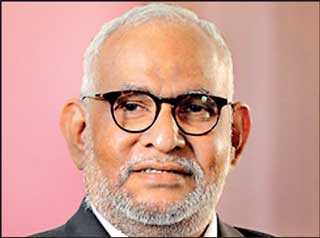Friday Jan 10, 2025
Friday Jan 10, 2025
Friday, 19 February 2021 00:22 - - {{hitsCtrl.values.hits}}
 |
| Chairman Jegan Durairatnum |
 |
| Director and CEO Lakshman Silva
|
Despite the adverse macro-economic challenges faced, DFCC Bank yesterday said it concluded the year ended 31 December 2020 with sound performance and growth. DFCC Bank PLC reported a profit before tax (PBT) of Rs. 3,398 million and a profit after tax (PAT) of Rs. 2,388 million for the year ended
31 December 2020. This compares with a PBT of Rs. 2,989 million and a PAT of Rs. 2,074 million in the previous year.
However, profit recorded in the comparable period includes the net fair value loss on investment in Commercial Bank’s equity securities of Rs. 754 million.
With the view of concentrating on core banking profitability, the bank has reclassified the investment made in the equity securities of Commercial Bank of Ceylon PLC from fair value through profit or loss to fair value through other comprehensive income, with the option given in the “Guidance Notes on Accounting Consideration of the COVID-19 Outbreak” issued by the Institute of Chartered Accountants of Sri Lanka. This reclassification helped the bank to focus more on its efforts to ensure core business profitability.
The Group recorded a PBT of Rs. 3,944 million and PAT of Rs. 2,847 million for the year ended 31 December 2020 as compared to Rs. 3,308 million and Rs. 2,300 million respectively in 2019. All the member entities of the Group made positive contributions to this performance.
Group includes Lanka Industrial Estates Ltd. (LINDEL), DFCC Consulting Ltd. (DCPL) and Synapsys Ltd. (SL), the Joint Venture Company, Acuity Partners Ltd. (APL) and Associate Company, National Asset Management Limited (NAMAL).
In a review accompanying 2020 results, DFCC Bank Director and CEO Lakshman Silva said, whilst the country was in the process of recovering from the incidents of 2019, the banking industry in particular, being an essential service, was flung into unprecedented market conditions in the wake of the global COVID-19 pandemic. “With the industry encountering various challenges from the first quarter, 2020 has been a year full of trials, having to work under the new normal. With many interruptions, the period between June to October before the second wave of COVID noticed a significant growth momentum and development.”
He said DFCC Bank was equipped with a readiness to handle each market situation, putting adaptability and customer-centricity to the forefront of each business process. Every effort was made to ensure that customers experienced uninterrupted banking facilities whilst significant changes were made to working arrangements in order to deliver a seamless banking experience.
DFCC Bank adapted to the ‘new normal,’ innovating wherever possible and digitising processes in order to cater to an ever-evolving market. The bank introduced several concessionary schemes to its clientele in accordance with the Directions/ Guidelines of Central Bank of Sri Lanka extending financial and advisory support to all segments of customers.
The following commentary relates to the Audited Financial Statements for the year ended 31 December 2020, presented in accordance with Sri Lanka Accounting Standard 34 (LKAS 34) on “Interim Financial Statements”.
Financial Performance
Gross Income
Regardless of today’s challenging environment, the bank was able to maintain its overall income level in 2020. The Bank’s total income for the year 2020 was Rs. 43,300 million compared to the previous period of Rs. 43,297 million. The interest income amounts to 90% of the total income of the bank.
Fee and Commission Income
The slowdown of the economic activities and relief measures introduced has had serious implications to the fee and commission income of the banking industry. However, the concentrated effort to increase non-funded business has materialised with a slight increase to Rs. 2,061 million for the year ended 31 December 2020, from Rs. 2,046 million in the comparative period despite the adverse impact of the COVID-19 pandemic and reduction of some fees and charges by the bank as required by the regulator.
Net Interest Income
The bank recorded a Rs. 11,007 million in net interest income (NII) which is a 13% decline year on year, primarily due to a drop in AWPLR more than 400 bps over the past 12 months and due to the business implications, that arose after 18 March 2020 resulting from the pandemic situation and various measures introduced by Central Bank of Sri Lanka, including concessions granted as pandemic relief to borrowers. As a result, the interest margin decreased to 2.53% in December 2020 from 3.25% in December 2019.
Impairment Charge on Loans and Other Losses
Due to the uncertain economic outlook and the potential future impacts of COVID-19 on our lending portfolio, DFCC Bank placed additional focus on Expected Credit Loss (ECL) provisions based on the internal models, management overlay computed based on stress testing the exposures to risk elevated sectors and the moratorium schemes introduced to support the recovery of the economy. The bank also considered the long-term economic trend in calculating the impairment provision in line with the guideline issued by the Institute of Chartered Accountants of Sri Lanka, as the economic downturn cannot be reasonably estimated. With the above, DFCC Bank continued to be as prudent as in the past in assessing the quality of the credit portfolio and making adequate provisions. DFCC Bank’s non-performing loans (NPL) ratio moved up to 5.56% in December 2020 from 4.85% in December 2019 in line with the overall banking sector growth in NPLs. Considering all these factors, the bank’s total impairment charge increased by 98% from Rs. 1,669 million to Rs. 3,298 million for the year ended 31 December 2020. Furthermore, as the impacts of the COVID-19 pandemic will continue to be felt for some time, the bank continues to closely monitor its loan portfolio and provisioning levels.
Operating Expenses
As a result of effective cost management procedures followed under the pandemic environment, the bank was successful in recording a decline of 2% in total operating expenses to Rs. 7,387 million in year 2020. This was achieved while introducing many safety measures across the branch network in order to provide a seamless service to customers and to secure a safe environment to employees and all stakeholders. To better aid our internal processes, the bank launched Google G-Suit enterprises that enabled a smooth transition for our staff to work from home with minimal disruption to their day-to-day activities, with zero impact on banking operations. During the year, the bank created multiple channels for service delivery to access customers and provide uninterrupted services during this pandemic situation which also contributed towards an increase in revenue streams, deposits and the bank’s customer base. Careful monitoring and effective cost control measures adopted during the year helped to reduce the operating expenses to this level and resulted in a cost to income ratio of 48.97% for 2020.
Profitability
The basic earnings per ordinary share (EPS) of the bank improved to Rs. 7.83 in 2020 from Rs. 7.14 in 2019 recording an increase of 9.7%. DFCC declared a final dividend of Rs. 3 per share in the form of a scrip dividend for the year 2020. The bank’s Return on Equity (ROE) improved to 4.93% in 2020 from 4.54% in 2019. The bank’s Return on Assets (ROA) before tax was 0.78% and maintained at the same level as the previous year.
Other Comprehensive Income
Investments in equity securities and treasury bills and bonds (fixed income securities) are classified as financial assets, and the change in fair value is recorded through other comprehensive income. Accordingly, fair value losses of Rs. 1,533 million and a net fair value gain of Rs. 2,617 million were recorded on account of equity and fixed income securities, respectively. The drop in the share price of Commercial Bank of Ceylon during the period mainly contributed to the reported fair value loss in equity securities, whilst the movement of interest rates of treasury bills and bonds favourably resulted in the fair value gain that was recorded during the period.
Balance Sheet Growth and Funding
Assets
Despite the challenges faced by the Economy and Banking Sector, DFCC Bank’s total assets increased by Rs. 60,180 million recording a growth of 15% from December 2019. This constitutes a loan portfolio growth of Rs. 29,091 million to Rs. 301,909 million compared to Rs. 272,818 million as at 31 December 2019, recording an increase of 11%. Following the bank’s prudent lending policies, it did not pursue aggressive growth particularly to sectors that exhibited stress. The bank has implemented a number of relief schemes in line with the directives from the Central Bank of Sri Lanka to support those customers affected. This includes over 1,826 Saubagya COVID-19 working capital loans amounting Rs. 10 billion approved for affected customers. The bank’s net asset value per share grew by 3% to Rs. 161.30 from Rs. 156.09 in 2019.
Liabilities
The liabilities increased by 16% over the previous year to Rs. 415,720 million as at the year end with a significant growth in customer deposits by 25% amounting to Rs. 62,240 million. Accordingly, DFCC Bank was able to record a loan to deposit ratio of 97.38%.
The bank’s CASA ratio, which represents the proportion of low-cost deposits in the total deposits of the bank, was 23.8% as at 31 December 2020. Funding costs for DFCC Bank were also contained due to access to medium to long-term concessionary credit lines. When these concessionary term borrowings are considered, the ratio improved to 30.19% as at 31 December 2020.
DFCC Bank continued its approach to tap local and foreign currency-related long to medium-term borrowing opportunities.
Equity and Compliance with Capital Requirements
DFCC Bank’s total equity increased to Rs. 49,357 million as at 31 December 2020 from Rs. 47,480 million in December 2019. The main contributor to the increase was the growth in retained earnings by Rs. 1,424 million.
The bank expects the debt moratorium and concessionary working capital loans introduced by the Central Bank of Sri Lanka to help businesses recommence operations and reach normalcy soon. However, reduction in the cash flows from moratoriums and delayed payments by customers who did not enjoy moratoriums would likely contribute towards a negative impact on the earnings, cash flows and liquidity position of the bank. Based on the internal assessment undertaken by the bank, there is no significant adverse impact to the regulatory capital ratios maintained by the bank. As a further reinforcement to Tier II Capital requirements, the bank has issued a listed, rated, unsecured, subordinated, redeemable debenture of Rs. 4.5 billion during the fourth quarter of 2020. In order to support future growth as a full-service retail bank, the bank has consistently maintained a capital ratio above the Basel III minimum capital requirements. As at 31 December 2020, the bank recorded Tier 1 and total capital adequacy ratios of 10.82% and 15.76%, respectively, which is well above the minimum regulatory requirements of 8% and 12% including Capital Conservation buffer of 2%.
“As we move ahead it is to be noted that the banking sector underwent a phase of digital transformation over the recent past and this has now been accelerated with the need to be accessible during an unforeseen situation. DFCC will continue to provide solutions to customer transactions while operating remotely thus creating opportunity to convert the traditional customer to a modern and digitally enabled one,” DFCC Bank CEO Silva said. “The banking sector can remodel their operations where the brick-and-mortar infrastructure that is already in place will concentrate more on adding value towards selling banking products and services rather than dealing with transactions, thus increasing customer engagement and building and enhancing customer relationships.”